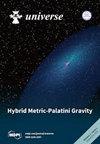Constraint on the Cosmic Curvature in a Model with the Schwarzschild–de Sitter Metric from Supernovae and Gamma-Ray Burst Observational Data
IF 2.5
4区 物理与天体物理
Q2 ASTRONOMY & ASTROPHYSICS
引用次数: 0
Abstract
In developing his cosmological model of 1917, de Sitter theoretically predicted the phenomenon of cosmological redshift (the de Sitter effect), which he did long before the discovery of this phenomenon in observations. The de Sitter effect is gravitational by its nature, as it is due to differences between the coordinate systems of the observer and the distant source. However, the relationship between the redshift and distance derived from the de Sitter metric is at odds with observations, since this relationship is nonlinear (quadratic) for small redshifts, while the observed relationship between the same quantities is strictly linear. This paper discusses the possibility that cosmological redshift is gravitational by its nature, as in de Sitter’s 1917 model. At the same time, here, as in de Sitter’s model, an elliptical space is used, the main characteristic of which is the identification of its antipodal points. But, unlike de Sitter’s model, here, in order to ensure strict linear dependence of the redshift on distance, the origin of the reference system is transferred to the observer’s antipodal point. The Schwarzschild–de Sitter metric used in this model allows you to estimate the curvature of space from observational data. To achieve this, a theoretical Hubble diagram is built within the framework of the model with the Schwarzschild–de Sitter metric, which is compared with observations from the Pantheon+ catalogue of type Ia supernovae and the Amati catalogue of gamma-ray bursts in the redshift range of 0从超新星和伽马射线暴观测数据看施瓦兹希尔德-德-西特公设模型中的宇宙曲率约束
在 1917 年建立宇宙学模型时,德-西特从理论上预言了宇宙学红移现象(德-西特效应),这比观测发现这一现象要早得多。德西特效应的本质是引力效应,因为它是由观察者和遥远来源的坐标系之间的差异造成的。然而,根据德西特度量得出的红移和距离之间的关系与观测结果不符,因为对于小红移来说,这种关系是非线性的(二次关系),而观测到的相同数量之间的关系却是严格的线性关系。本文讨论了宇宙学红移本质上是引力红移的可能性,就像在德-西特 1917 模型中一样。同时,与德-西特模型一样,本文也使用了椭圆空间,其主要特征是确定其对跖点。但是,与德西特模型不同的是,为了确保红移与距离的严格线性关系,这里参考系的原点被转移到了观测者的对跖点。该模型中使用的施瓦兹希尔德-德-西特度量可以根据观测数据估算空间曲率。为此,我们在施瓦兹希尔德-德-西特度量模型的框架内建立了一个理论哈勃图,并将其与红移范围为 0
本文章由计算机程序翻译,如有差异,请以英文原文为准。
求助全文
约1分钟内获得全文
求助全文
来源期刊

Universe
Physics and Astronomy-General Physics and Astronomy
CiteScore
4.30
自引率
17.20%
发文量
562
审稿时长
24.38 days
期刊介绍:
Universe (ISSN 2218-1997) is an international peer-reviewed open access journal focused on fundamental principles in physics. It publishes reviews, research papers, communications, conference reports and short notes. Our aim is to encourage scientists to publish their research results in as much detail as possible. There is no restriction on the length of the papers.
联系我们:info@booksci.cn
Book学术提供免费学术资源搜索服务,方便国内外学者检索中英文文献。致力于提供最便捷和优质的服务体验。
Copyright © 2023 布克学术 All rights reserved.
京ICP备2023020795号-1
 京公网安备 11010802042870号
京公网安备 11010802042870号
京ICP备2023020795号-1

Book学术文献互助群
群 号:481959085

 求助内容:
求助内容: 应助结果提醒方式:
应助结果提醒方式:
